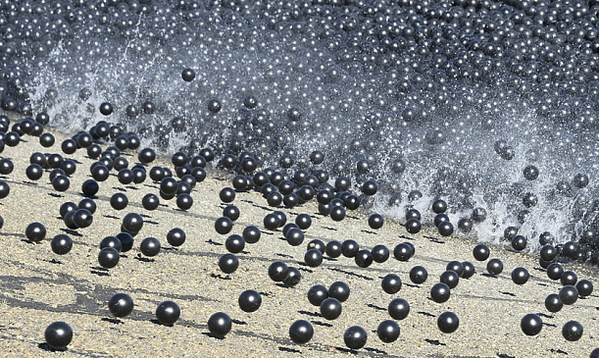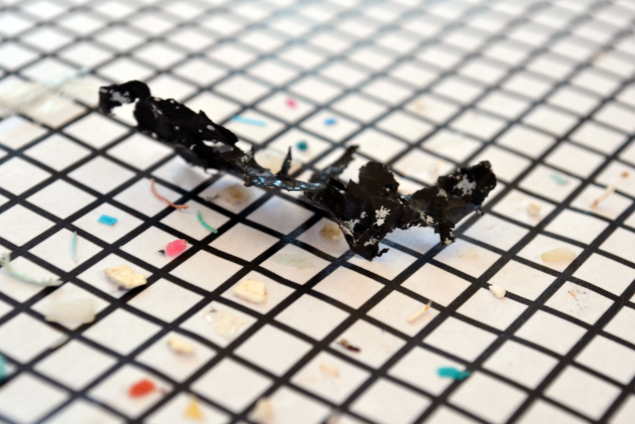LA’s Shade Balls: The ecological costs of plastics in water
Max
Liboiron
From @rrosewarne Twitter feed.
16
August. 2015
The
media has widely reported on the 20,000 black plastic balls tumbling
down the slopes of Los Angeles Reservoir last week. Covering a body
of water with black plastic balls (aka. “Shade Balls”) when
people have been warned against throwing plastic into waterways has
sparked a number of questions. Even though there are metal covers for
standing water, the city opted for much cheaper plastic. What are the
ramifications of this choice for ecological and human health?
Luckily, we have a plastics expert at Discard Studies. Dr. Max
Liboiron has been studying marine plastics and their chemicals for 8
years. Most of what we know about how plastics behave in water are
from studying marine plastic pollution, but the concepts are the same
regardless of the body of water and the intent behind the plastic:
1. Plastics
leach chemicals into water. Plastics are polymers. Polymers have
long, strong molecular bonds that keep plastics from biodegrading,
and are what make plastics strong and flexible. But if you want your
plastic to be UV resistant, black, extra flexible, or give it other
properties, you add monomers. Monomers are made of shorter molecular
chains, and they aren’t chemically bonded to the polymers. Which
means they leach and offgas. You’ll see this in everyday plastics;
as they get old and lose mononers, they also lose color and get
brittle. While the exact composition of the HDPE used in the Shade
Balls hasn’t been released, HDPE is a fairly safe plastic.
Except
we know there are chemicals in the balls that are for UV resistance.
Those will leach. The black additive is carbon black, which isn’t
supposed to be harmful when it leaches, which is great. Yet even with
this precaution, most plastics leach endocrine disrupting chemicals
that interfere with animal and human hormone systems (Yang 2011).
Some endocrine disruptors, like bisphenol A (BPA), break down in
water after a few weeks or months. Some don’t. We don’t know what
chemicals are in the Shade Balls, but they will leach, especially
because the balls are in the hot sun and are meant to be left in the
water over a long period (reports say 10 years). Most water treatment
systems don’t take these kinds of chemicals out of the water.
2. Plastics
fragment in the environment. Most plastics found in the marine
environment start out as larger objects you would easily recognize,
like plastic bags and toothbrushes. Or balls. Over time, they
fragment into tiny microplastics. 92% of the 5.25 trillion plastic
pieces floating on the surface of oceans (Eriksen 2014) are smaller
than a grain of rice because plastics don’t decay into their
constituent molecules like organic substances. Instead, they fragment
into smaller and smaller bits.
Plastic fragments found in the North Atlantic. Photo by Annie McBride. 2015.
3. Plastic
fragments are ingested by marine life.The problem with micoplastics
is that the are ingested by a wide variety of marine life. Some are
so small they can be eaten by plankton or circulate in the blood of
mussels (Browne 2008). Plastics can cause choking, but the bigger
concern is that plastics are a way that chemicals move into animal
tissues and food chains.
4. Plastics
are magnets for chemicals. Plastics can absorb more than a million
times more chemicals than the surrounding water, making them very
toxic (Mato 2001). If you’ve ever done dishes after eating leftover
spaghetti or curry, you know that orange color that’s so hard to
scrub off plastic Tupperware. That is an example of how oily
substances are attracted to plastics. Absorbed chemicals include DDT,
flame retardants, and other persistent organic pollutants (POPs)
(Rochman 2012, Teuten 2009). Scientists nickname ocean plastics
“poison pills” because when an animal eats the plastic, the
chemicals move into its body as well. These chemicals also become
more concentrated as they move up the food chain (biomagnification).
5. Plastics
provide habitat for microbes and other forms of life. Scientists have
found that plastics support unique ecosystems, from microbes to fish.
They call this the “plastisphere” (Zettler 2013). So while the
Shade Balls might block sunlight that encourages algae growth, they
are simultaneously providing habitat for other life, including but
not limited to algae.
6. Plastics
escape infrastructure. Scientists and governments first became
concerned about marine plastics in the 1990s. At the time, they
thought that people were dumping garbage straight into the ocean and
on beaches. In fact, most marine plastics come from land (Browne
2011). Plastics are very light and durable and they fly, flow, and
are carried into new environments all the time. Those Shade Balls
will go places they aren’t meant to go, and will continue to leach
chemicals, fragment, and be ingested in new environment.
7. The
scale of the problem and the scale of the solution are mismatched.
The 300 million gallons of water a year that the shade balls are
supposed to capture that would otherwise evaporate is actually a
small number when compared to the amount of water being used at
industrial scales. For example, the Washington Post crunched the
numbers and argues that if California agriculture increased its water
efficiency by only 5%, they would save 500 billion gallons of water
in a few months. Fracking uses 2.14 million gallons of fresh water
every day. One of the most common problems in environmental
solutionism is trying to solve massive problems with tiny solutions.
This is one of those case.
8. Technological
fixes for systemic problems usually lead to more problems. To be
fair, California is screwed. There is no water in a populous state.
And it’s not going to get better soon. They have to come up with
solutions, and fast. Will the shade balls keep 300 million gallons of
water from evaporating? Yes. Is the short term gain worth the long
term costs? This is the question. Grand technological gestures in the
face of massive systemic problems like perpetual drought makes it
feel as though action is possible. It’s doing something. But short
term technological fixes for long term systemic problems usually lead
to their own problematic ripple effects. These are called “wicked
problems” and they account for most large scale environmental and
urban planning problems. It’s like the woman who swallowed the fly.
There are a lot of environmental costs to the Shade Ball fix for
relatively little gain, even though little gains might matter in
California right now. Yet, as suggested in the point above, there are
other solutions that scale better. If we are going to deal with
California’s continuing drought, with climate change, with ocean
plastics, and the other types of complex, large scale problems
characteristic of the 21st century, we need to step away from
technical fixes and focus on larger systemic approaches that
incorporate the bigger players, like industry.
This
post is based on a basic literature review of the state of the art of
science on marine plastics. If you’re still curious about how
plastics behave in water environments, there is a great new open
access book, Marine Anthropogenic Litter, that is written by
scientists but readable by a public audience that covers the science
in greater detail.
Cited:
Bergmann,
M., Gutow, L., & Klages, M. (2015). Marine
Anthropogenic Litter.
Springer. This open-access text is the most comprehensive collection
on marine plastics.
Browne,
M. A., Dissanayake, A., Galloway, T. S., Lowe, D. M., & Thompson,
R. C. (2008). Ingested
microscopic plastic translocates to the circulatory system of the
mussel, Mytilus edulis (L.). Environmental
science & technology, 42(13),
5026-5031.
Browne,
M., Crump, P., Niven, S., Teuten, E., Tonklin, A., Galloway, T.,
Thompson, R. (2011). Accumulation
of Microplastic on Shorelines Worldwide: Sources and Sinks, Environ.
Sci. Technol., 45
(21), pp 9175–9179
Eriksen
M., et al. (2014). Plastic
pollution in the world’s oceans: More than 5 trillion plastic
pieces weighing over 250,000 tons afloat at sea. PloS
ONE 9(12).
Kang,
J. H., Aasi, D., & Katayama, Y. (2007). Bisphenol
A in the aquatic environment and its endocrine-disruptive effects on
aquatic organisms. Critical
reviews in toxicology, 37(7),
607-625.
Mato,
Y., Isobe, T., Takada, H., Kanehiro, H., Ohtake, C., Kaminuma, T.,
(2001).Plastic
resin pellets as a transport medium for toxic chemicals in the marine
environment. Environmental
Science and Technology 35,
318–324.
Rochman,
C. M., Hoh, E., Kurobe, T., & Teh, S. J. (2013). Ingested
plastic transfers hazardous chemicals to fish and induces hepatic
stress. Scientific
reports, 3.
Teuten
E, Saquing J, Knappe D, Barlaz M, Jonsson S, et al. (2009). Transport
and release of chemicals from plastics to the environment and to
wildlife.
Philos Trans R Soc Lond B Biol Sci 364: 2027-2045.
Yang,
C. Z., Yaniger, S. I., Jordan, V., Klein, D. J., & Bittner, G. D.
(2011). Most
plastic products release estrogenic chemicals: a potential health
problem that can be solved. Environmental
Health Perspectives, 119(7),
989-996.
Zettler,
E., Mincer, T., Amaral-Zettler, L., (2013). Life
in the “Plastisphere”: Microbial communities on plastic marine
debris.
Environmental Science and Technology 47, 7137-7146.
Dr. Max
Liboiron is
an Assistant Professor of culture and technology at the Memorial
University of Newfoundland. Liboiron’s dissertation, Redefining
Pollution: Plastics in the Wild looks
at how the science of pollution around plastics is changing the face
of science and activism. Liboiron now directs the Civic
Laboratory for Environmental Action Research (CLEAR), which
creates citizen science tools for environmental monitoring in extreme
environments with a specialization in marine plastics.





No comments:
Post a Comment
Note: only a member of this blog may post a comment.